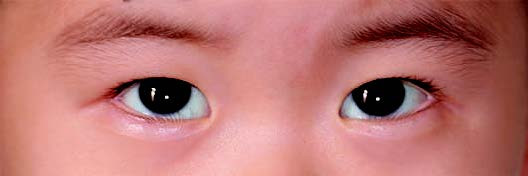Entropion refers to an abnormal eyelid position in which the eyelid margin is turned inward toward the eyeball. Entropion frequently coexists with trichiasis (misdirected eyelashes). Based on the underlying cause, entropion can be classified into congenital entropion, involutional entropion, and cicatricial entropion.
Congenital Entropion
Congenital entropion is most commonly observed in infants and young children and is often caused by epicanthal folds, overdeveloped orbicularis oculi muscle in the eyelid margin, or underdevelopment of the tarsal plate. Additionally, a chubby infant with underdeveloped nasal bridge may also develop lower eyelid entropion.

Figure 1 Appearance of congenital entropion
The patient exhibits bilateral lower eyelid entropion and trichiasis.
Involutional Entropion
Involutional entropion typically occurs in the lower eyelid and is more common in elderly individuals, thus also referred to as senile entropion. It is caused by weakened retractors of the lower eyelid, laxity of the orbital septum and lower eyelid skin, which reduces the restraining effect on the orbicularis oculi muscle contractions, as well as orbital fat atrophy in elderly individuals leading to insufficient posterior support for the eyelid.
Cicatricial Entropion
Cicatricial entropion can occur in both the upper and lower eyelid and results from scar contraction in the palpebral conjunctiva and tarsal plate. It can be associated with trauma, conjunctival burns, or conditions such as cicatricial pemphigoid.
Clinical Manifestations
Congenital entropion often affects both sides, while cicatricial entropion is frequently unilateral. Symptoms include photophobia, tearing, foreign body sensation, stabbing pain, and a rubbing sensation. Clinical examination reveals an inward turning of the eyelid margin, causing friction against the cornea. Corneal epithelium may erode, with diffuse staining observed using fluorescein dye. Secondary infection can lead to corneal ulceration. Long-term untreated cases may develop corneal neovascularization, opacities, or even leukomas, resulting in vision impairment.
Diagnosis
The diagnosis is typically straightforward and is based on factors such as the patient’s age, history of trauma or surgery, and characteristic clinical manifestations.
Treatment
Congenital entropion often resolves spontaneously as the nasal bridge develops with age, and immediate surgical intervention is usually unnecessary. However, surgical treatment may be considered if the entropion is severe and causes prolonged corneal irritation and damage.
Involutional entropion is related to factors such as reduced horizontal tension of the eyelid, and most cases require surgical correction.
Cicatricial entropion always necessitates surgical treatment.